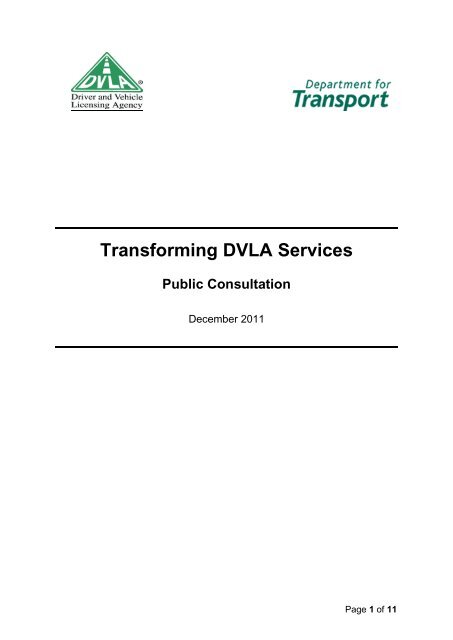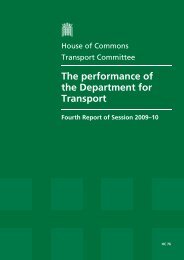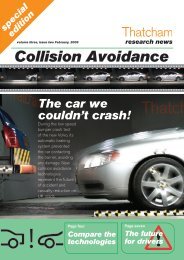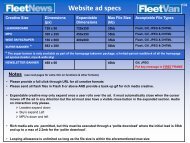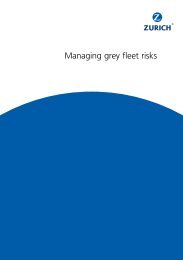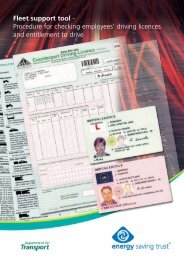Transforming DVLA Services' can be downloaded here - Fleet News
Transforming DVLA Services' can be downloaded here - Fleet News
Transforming DVLA Services' can be downloaded here - Fleet News
You also want an ePaper? Increase the reach of your titles
YUMPU automatically turns print PDFs into web optimized ePapers that Google loves.
<strong>Transforming</strong> <strong>DVLA</strong> ServicesPublic ConsultationDecem<strong>be</strong>r 2011Page 1 of 11
Table of ContentsBackground .................................................................................................... 3Customer Insight and Feedback .................................................................. 4Surveys ..................................................................................................... 4Building Future Services Around Customer Needs and Expectations ..... 4The Plans ................................................................................................... 4What This Will Look Like For The <strong>DVLA</strong>’s Customers ............................... 5What This Will Deliver ................................................................................ 6Your Views ..................................................................................................... 6What We Need From You .......................................................................... 6How To Respond ........................................................................................ 7Annex A: Code of Practice on Written Consultation ....................................... 9Annex B: Reply Form ................................................................................... 11Page 2 of 11
How customers have reacted1.6 A growing num<strong>be</strong>r of the <strong>DVLA</strong>’s customers are now choosing to useelectronic services. Over 49% of vehicle licensing transactions are carried out onlineor by phone, 87% of first vehicle registrations are made through the automatedsystem and 25% of driver licensing applications are completed online.What impact has this had1.7 Electronic services are cheaper to deliver and the <strong>DVLA</strong> has <strong>be</strong>enencouraging customers to take up those services that are available. This allows the<strong>DVLA</strong> to increase the efficiency of its operations helping to deliver <strong>be</strong>tter services toall customers.2. CUSTOMER INSIGHT AND FEEDBACKSurveys2.1 We continue to listen to our customers and it is clear that many want <strong>DVLA</strong> toaccelerate the rate of change and make further improvements.2.2 The <strong>DVLA</strong>’s last annual customer survey suggested that 90% of commercialcustomers expect to use the Internet to transact with the Agency. Commercialcustomers have indicated that the continued development of electronic channels iscentral to the success of their own businesses.Some of the things our customers have said:‘....technologies need to <strong>be</strong>tter reflect the needs of its customers....’‘....antiquated procedures which disregard the role of modern technology are costingboth the <strong>DVLA</strong> and fleet operators’ money....’‘....we would urge the Agency and Government to develop IT systems which caterfor all users....’‘....it would relieve a portion of the administrative burden if amendments weremade....to allow vehicle registration documents to <strong>be</strong> issued electronically....’3. BUILDING FUTURE SERVICES AROUND CUSTOMER NEEDS ANDEXPECTATIONSThe plans3.1 The <strong>DVLA</strong> understands that the demands and expectations of customers arechanging. The aim is to build service channels around what customers want(speed, accuracy and convenience). At the same time the <strong>DVLA</strong> must reduce itsrunning costs. The key elements that will allow us to achieve this are doing thingsonline, rationalising our estate and centralising functions at the <strong>DVLA</strong> to simplify ourPage 4 of 11
delivery model. This means driving forward existing services such as increasingtake up of driver services online. It also means making other transactions availableelectronically w<strong>here</strong> this is cost effective and maximising uptake by making them asuser friendly as possible.What this will look like for the <strong>DVLA</strong>’s customers3.2 Individual motorists and businesses will find that more of what they need todo <strong>can</strong> <strong>be</strong> done electronically, rather than just through traditional channels.Transferring a personalised num<strong>be</strong>r plate to another vehicleWhat you have to do nowComplete a paper application, enclose supporting documentation and arrangedelivery to a <strong>DVLA</strong> Local Office – either in person or by post.What will happen in the futureIn the short term we will increase efficiency by reducing the bureaucracy andcentralising the transaction. When it has <strong>be</strong>en simplified, we will put the serviceonline, potentially through intermediaries.Vehicle Keeper DetailsWhat you have to do nowA vehicle keeper wanting to tell the <strong>DVLA</strong> about a change of address must completea section on the vehicle registration document (for each vehicle) and return this bypost to the <strong>DVLA</strong>.What will happen in the futureA new address could <strong>be</strong> notified online which would update all the <strong>DVLA</strong> records.T<strong>here</strong> would <strong>be</strong> no need to return each vehicle’s registration document to the <strong>DVLA</strong>for amendment.3.3 The <strong>DVLA</strong> recognises that t<strong>here</strong> is still potential for growth in existingelectronic services. T<strong>here</strong> are those who, for a num<strong>be</strong>r of reasons, <strong>can</strong>not accessthese channels or who choose not to. We are looking to remove obstacles totransacting online w<strong>here</strong>ver possible. We also want to tackle issues around accessto electronic services to increase inclusivity. This means making them available:As self-service facilities – w<strong>here</strong> the customer <strong>can</strong> carry out driver and vehicletransactions electronically using their home internet or telephone.Through one or more intermediaries potentially available through a range ofoutlets – these will allow customers to transact with the <strong>DVLA</strong> through a front officecounter service provider who will make facilities available and help the customer usethe <strong>DVLA</strong>’s electronic services.Page 5 of 11
3.4 This does not mean we will leave <strong>be</strong>hind those who still do not use ourelectronic services. The <strong>DVLA</strong> will consider how we <strong>can</strong> meet the needs of peoplewho may require face-to-face and postal services.What this will deliver3.5 T<strong>here</strong> are already a num<strong>be</strong>r of services available electronically and take-upof these is forecast to increase with another 250k extra customers expected to haverenewed their photocard licence on line by April 2012. Work on developing the<strong>DVLA</strong>’s electronic services further is ongoing. This will identify the costs and<strong>be</strong>nefits involved in each individual change. The <strong>DVLA</strong> expects that signifi<strong>can</strong>tongoing savings will <strong>be</strong> made overall and that these will outweigh the one offdevelopment and change costs involved.3.6 Streamlining processes means examining the way in which the <strong>DVLA</strong>provides all its services including delivery of face-to-face operations. Currently 39Local Offices provide an over the counter service to around 2.5 million customersper year and 10 regional centres provide enforcement activities. These services areexpensive to operate with 23.3% of overall Agency headcount delivering only 5.7%of the overall Agency workload. T<strong>here</strong>fore, the <strong>DVLA</strong> needs to identify differentways of delivering these services to increase efficiency and value for money. The<strong>DVLA</strong> will look at rationalising activities and then centralising remaining functions atits Headquarters in Swansea. The <strong>DVLA</strong> <strong>be</strong>lieve this is a necessary step in thejourney to deliver savings.3.7 Centralisation will not mean a down grading of service to the <strong>DVLA</strong>’scustomers. Neither will it mean that enforcement activities will <strong>be</strong> less stringent andeffective than in the past. It will provide savings in overheads and a more localisedservice to customers through a wider range of intermediaries <strong>be</strong>ing able to offer<strong>DVLA</strong> products and services.4. YOUR VIEWSWhat we need from you4.1 The <strong>DVLA</strong>’s customer base is diverse with differences in outlook and needs.We also know that whatever the <strong>DVLA</strong> does to update its services it will impact onthe wider public. Many support the direction the <strong>DVLA</strong> is taking but t<strong>here</strong> will <strong>be</strong>others who will have issues with the transformation <strong>be</strong>ing made. In framing the workwe are doing, we need to make sure we:- consider the needs and views of all our customers and those affected;- take account of wider implications; and- have a clear understanding of what our priorities should <strong>be</strong>.Page 6 of 11
This is w<strong>here</strong> we need your help.QuestionsDo you support the direction of the changes <strong>be</strong>ing proposed?Do they raise issues for you and, if so, what are they?What kind of services would you like to see <strong>be</strong>ing delivered through:- electronic services- intermediariesWhat would <strong>be</strong> of most <strong>be</strong>nefit to you?If you don’t currently use the <strong>DVLA</strong>’s online services, why not?Would you use electronic channels if access was provided through a local service orbusiness operating as an intermediary?If not, what other ways could we help you to use electronic services?In view of the above, what problems would you foresee with the centralisation of thefunctions currently provided by the <strong>DVLA</strong>’s 39 Local Offices and 10 EnforcementOffices?How to respondIf you are affected by the changes proposed in this consultation, please consider thequestions above. As part of your response we would <strong>be</strong> interested in receiving anyviews on the matters included within this document. Responses should <strong>be</strong> made byTuesday 6 March 2012.When responding, it would <strong>be</strong> helpful if groups could indicate the people andorganisations they represent.You <strong>can</strong> respond in the following ways:Post to Corporate Affairs Directorate, D16, <strong>DVLA</strong>, Swansea, SA6 7JLEmail to consultations.cad@dvla.gsi.gov.ukPlease use one of the above contacts to request a copy of the consultation in analternative format (hard copy, Braille, audio CD etc) or if you have any questions.Page 7 of 11
What happens nextWe do not intend to acknowledge receipt of individualresponses unless you indicate that you would like anacknowledgement.<strong>DVLA</strong> replyWe are unable to reply individually to the points youmay raise as part of your reply.A summary of responses will <strong>be</strong> published within 3months of the consultation closing onwww.dft.gov.uk/consultations. Those who haveresponded to the consultation will <strong>be</strong> notified when thishappens.We may publish all or some of the comments wereceive in relation to this consultation. Please note thatif <strong>DVLA</strong> receives a request from any third party for sightof such comments, we may <strong>be</strong> obliged by law (forexample under the Freedom of Information Act 2000) todisclose such information to the appli<strong>can</strong>t.Confidentiality ofresponsesIf t<strong>here</strong> are particular reasons why you would not wishyour comments to <strong>be</strong> disclosed or published, please letus know. Although your wishes may not override anystatutory obligations to disclose, they will <strong>be</strong> taken intoaccount as far as possible.If you reply by email, the statements made aboveoverride any confidentiality disclaimer generated byyour IT system.Code of practiceThis consultation complies with the Code of Practice onWritten Consultation (see Annex A).Page 8 of 11
ANNEX A: Code of Practice on Written ConsultationThe code of practice applies to all UK public consultations by government departmentsand agencies, including consultations on EU directives.Though the code does not have legal force, and <strong>can</strong>not prevail over statutory or othermandatory external requirements (e.g. under European Community Law), it shouldotherwise generally <strong>be</strong> regarded as binding unless Ministers conclude that exceptionalcircumstances require a departure.The following seven criteria must <strong>be</strong> reproduced within all consultation documents. T<strong>here</strong>should <strong>be</strong> an explanation of any departure from the criteria and confirmation that theyhave otherwise <strong>be</strong>en followed.Consultation CriteriaCriterion 1 - When to consultFormal consultation should take place at a stage when t<strong>here</strong> is scope to influencethe policy outcome.Criterion 2 - Duration of consultation exercisesConsultations should normally last for at least 12 weeks with consideration givento longer timescales w<strong>here</strong> feasible and sensible.Criterion 3 - Clarity of scope and impactConsultation documents should <strong>be</strong> clear about the consultation process, what is<strong>be</strong>ing proposed, the scope to influence and the expected costs and <strong>be</strong>nefits ofthe proposals.Criterion 4 - Accessibility of consultation exercisesConsultation exercises should <strong>be</strong> designed to <strong>be</strong> accessible to and clearly targetedto those people the exercise is intended to reach.Criterion 5 - The burden of consultationKeeping the burden of consultation to a minimum is essential if consultations areto <strong>be</strong> effective and if consultees’ buy-in to the process is to <strong>be</strong> obtained.Criterion 6 - Responsiveness of consultation exercisesConsultation responses should <strong>be</strong> analysed carefully and clear feedback should<strong>be</strong> provided to participants following the consultation.Criterion 7 - Capacity to consultOfficials running consultations should seek guidance in how to run an effectiveconsultation exercise and share what they have learned from the experience.A full version of the Code of Practice is available on the Department for BusinessInnovation & Skills website at:http://www.bis.gov.uk/files/file47158.pdfPage 9 of 11
If you consider that this consultation does not comply with the code or you havecomments about the consultation process please contactTim FordConsultation Co-ordinatorCorporate Affairs Directorate<strong>DVLA</strong>SwanseaSA6 7JLPage 10 of 11
ANNEX B: Reply FormYour Personal Details:Name:Organisation yourepresent (if any):Postal address:Telephone num<strong>be</strong>r:Fax num<strong>be</strong>r:e-mail address:CONSULTATION RESPONSE FORMTRANSFORMING <strong>DVLA</strong> SERVICES1. Do you support the direction of the changes <strong>be</strong>ing proposed?2. Do they raise issues for you and, if so, what are they?3. What kind of services would you like to see <strong>be</strong>ing delivered through:- electronic services- intermediaries4. What would <strong>be</strong> of most <strong>be</strong>nefit to you?5. If you don’t currently use the <strong>DVLA</strong>’s online services, why not?6. Would you use electronic channels if access was provided through a localservice or business operating as an intermediary?7. If not, what other ways could we help you to use electronic services?8. In view of the above, what problems would you foresee with the centralisation ofthe functions currently provided by the <strong>DVLA</strong>’s 39 Local Offices and 10Enforcement Offices?By post to Consultations at Corporate Affairs Directorate, D16, <strong>DVLA</strong>, LongviewRoad, SWANSEA, SA6 7JLBy e-mail to consultations.cad@dvla.gsi.gov.ukTHE CLOSING DATE FOR RESPONSES IS TUESDAY 6 MARCH 2012Page 11 of 11


